Bucket Racing is a discipline of motorcycle sport originating in New Zealand and also popular in Australia.
Bucket Racing is a discipline of motorcycle sport originating in New Zealand and also popular in Australia.
Bucket racing was originally started by motorcycling enthusiasts in New Zealand around 1980. The original idea was to take a low-powered commuter motorcycle with a maximum capacity of 150 cc and remove the entire road-going gear, thus creating the cheapest possible form of motorcycle racing. The name derives from the Bowdlerised slang phrase "bucket of shit"; rather than the usual finely tuned racing machines usual for racing circuits, the bikes used were often recycled ex–road machines that had crashed or fallen into disrepair.
It became very popular, and spread to Australia by 1988. At its height in the mid-1990s, there were up to 60 competitors at race meetings in New South Wales where the sport was most popular, divided into "Amateur" and "Pro" classes (junior and senior riders based on experience and ability).
As a form of inexpensive racing the class has competitors from teenagers to retirees, attracted to the sport by its low cost and accessibility. Bikes prepared for bucket racing sell for about $1,500.
As bucket racing developed, it was accompanied by enthusiasts, known as "Garagists", who developed their racing bikes into highly-crafted, fast racing machines. The addition of racing seats, fiberglass fairings, rear set footrests and gear changes and racing handlebars made some of the bikes replicas of more modern racing machines
In addition, home developers engineered the motors of their machines and significantly increased power outputs from the normal road going power of around 8–12 horse power to outputs in excess of 20 horse power. The home developers were able to create motors that produced power outputs equivalent to factory-produced GP race machines.
A well-developed bucket racer is on display at the National Motor Museum at Mount Panorama, Bathurst, New South Wales, and there is also a Honda H100 machine at the Powerhouse Museum in Sydney.
As the rules developed the machines separated into two classes. The original race bikes remained as Superlites, and a new class of Motolites was developed, allowing various engine types and capacity and unlimited development of any other part of the machine. The capacity sizes are: 111 cc Air-cooled 2 strokes, 85 cc Water-cooled 2 strokes, 159 cc 4-valve single-cylinder 4-stroke, 185 cc 2-valve single-cylinder 4-stroke, 159 cc 2-valve twin-cylinder 4-stroke, 200 cc 2-valve air-cooled single-cylinder 4-stroke.
The open rules encouraged the use of more modern and higher quality frames and running gear. Popular combinations include Honda RS125 frames with Honda CR85 engine, Yamaha TZ125 frames with Yamaha YZ85 engine, Moriwaki GP80 race bikes, Honda/Jiangshe 185 cc engines in a variety of frames and water-cooled 4 strokes such as the Honda CRF150 and CBR150. The commonly sought after levels of horsepower to be competitive are 28 hp for a two-stroke or about 25 hp for a four-stroke.
In New Zealand the rules have developed a slightly different classification system of bikes, with the maximum engine size in Formula 4; two strokes up to 100 cc water-cooled or 125 cc air-cooled and 4-strokes up to 150 cc water-cooled and Formula 5; 50 cc 2-strokes and 100 cc 4-strokes. The rules over what else can be used in the building of the motorcycle are broader, allowing more variety of bike parts, and consequently the development of widely differing machines with mixed results in performance.
The Commuterlite class, introduced in 2011, allows any ADR compliant 125cc 4 stroke motorcycle of any age to race. The rules only permit changes to exhaust, suspension gearing and bodywork, keeping costs down. The most common models running in this class are Honda CBR 125, Yamaha YZFR125, Aprilia RS4 125, and KTM Duke 125.

Motorenwerke Zschopau GmbH is a German motorcycle manufacturer located in Zschopau, Saxony. The acronym MZ since 1956 stands for Motorenwerke Zschopau GmbH. From 1992 to 1999 the company was called MuZ, an acronym for Motorrad und Zweiradwerk.

Motocross is a form of off-road motorcycle racing held on enclosed off-road circuits. The sport evolved from motorcycle trials competitions held in the United Kingdom.
Yamaha Motor Co., Ltd. is a Japanese mobility manufacturer that produces motorcycles, motorboats, outboard motors, and other motorized products. The company was established in the year 1955 upon separation from Nippon Gakki Co., Ltd. and is headquartered in Iwata, Shizuoka, Japan. The company conducts development, production and marketing operations through 109 consolidated subsidiaries as of 2012.
The Honda XR series is a range of four-stroke off-road motorcycles that were designed in Japan but assembled all over the world.
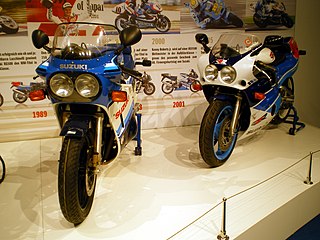
Suzuki GSX-R is a series of sports motorcycles made by Japanese automotive manufacturer Suzuki since 1984.
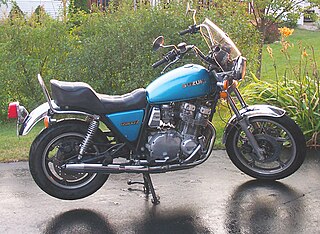
The Suzuki GS series was Suzuki Motor Corporation's first full range of 4-stroke powered road motorcycles, having previously almost exclusively manufactured 2-stroke machines. Suzuki had produced the 4-stroke Colleda COX 125cc and 93cc 4-stroke single-cylinder machines in 1955 however the rest of Suzuki's production from 1952 to 1976 had been increasingly sophisticated two-stroke road machines, whose ultimate expression was the 750cc 3-cylinder water-cooled GT750.
The Honda CR series was a line of two-stroke off-road motorcycles made by Honda from 1973 to 2007. They are racing motorcycles with countless trophies in the 125, 250 and 500 motocross classes. Marty Smith, Jeremy McGrath, Ricky Carmichael and many other motocross legends dominated racing circuits on Honda CR's. CR's continue competing today and are prized by racing enthusiasts and collectors alike.

A motorcycle engine is an engine that powers a motorcycle. Motorcycle engines are typically two-stroke or four-stroke internal combustion engines, but other engine types, such as Wankels and electric motors, have been used.

The Honda NR was a V-four motorcycle series started by Honda in 1979 with the 500cc NR500 Grand Prix racer that used oval pistons. This was followed during the 1980s by a 750cc endurance racer version known as the NR750. The oval piston concept allowed for eight valves per cylinder which generated more power due to the increased air/fuel mixture and throughout compression. In 1992 Honda produced around 300 street versions of a 750cc model, the NR, with a 90-degree V angle. Whereas the NR500 had used an oval piston with straight sides, the road going NR750 used an elliptical piston with curved long sides. The bike became the most expensive production bike at the time when it was selling for $50,000 and with the rarity, nowadays they rarely change hands.
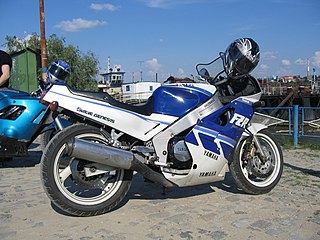
The Yamaha FZR1000 is a motorcycle produced by Yamaha from 1987 to 1995. Classed as a sports motorcycle.
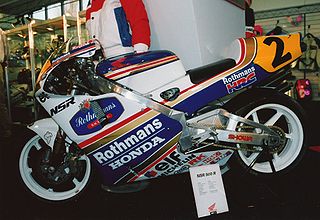
The Honda NSR500 is a road racing motorcycle created by HRC and debuted in 1984 for the Grand Prix motorcycle racing's 500 cc class. Honda won ten 500cc World Championships with the NSR500 from 1984 to 2002, with six in a row from 1994 to 1999. With more than 100 wins to its credit, the NSR500 is the most dominant force in modern Grand Prix motorcycle racing. The 1989 NSR500 that won Honda's third 500 World Championship with Eddie Lawson exemplifies the overwhelming power, acceleration and raw speed that has always been synonymous with Honda's 500 cc two-stroke V4.

The Ducati singles were single cylinder motorcycles, made by Ducati from 1950 to 1974. Chief Engineer Fabio Taglioni developed a desmodromic valve system in these years, a system that opens and closes the valves using the camshaft, without the need for valve springs. This valve system has become a trademark feature of Ducati motorcycles.

NR500 was a racing motorcycle developed by Honda HRC in 1979 to compete in Grand Prix motorcycle racing. "NR" stands for "New Racing".

The 50 cc class was the ultra-lightweight class in Grand Prix motorcycle racing, and formed part of the Fédération Internationale de Motocyclisme (FIM) World Championships from 1962 until 1983; when the class was replaced by 80 cc.

Formula 1000 (F1000) is a class of open wheel formula racing with professional and amateur series worldwide. Formula 1000 gets its name from the 1000 cc super-bike engine used to power a single seat, open wheel race car with fully adjustable wings and suspension.
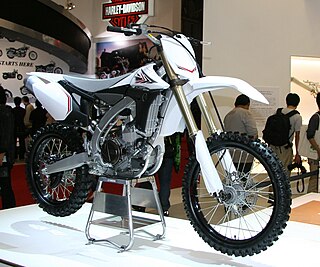
The Yamaha YZ450F is a four-stroke racing motocross bike built by Yamaha Motor Corporation. It was the successor to the previous YZ426F which was discontinued in 2003. It is credited by Cycle World and Dirt Rider magazines as the bike that started the four-stroke dirt bike revolution. The 2006 YZ250F and YZ450F were the first production motorcycles equipped with titanium suspension springs.

The Yamaha FZ750 is a sports motorcycle produced by Yamaha Motor Corporation between 1985 and 1991. The FZ750 is notable for several reasons, perhaps the most radical being the 5-valve cylinder head with a radial arrangement. This became something of a Yamaha trademark. The FZ750 would be the first bike in the Genesis design concept.

The MV Agusta 500cc Three (1965–1973) or MV Agusta Tre was a road racing motorcycle produced by the Italian manufacturer MV Agusta to compete in the 500 cc Grand Prix motorcycle racing World Championship. The motorcycle was introduced in 1966 to compete against the ever competitive Honda racing machines and was a bored out version of MV Agusta's highly successful 350 cc three cylinder. Giacomo Agostini won consecutive world championships in the 500 cc class with this motorbike from 1966 to 1972. In addition, MV Agusta won the Constructors' World Championships from 1967 to 1972. The MV Agusta Tre is considered the most successful racing motorcycle in history.

The MV Agusta 350 6 cilindri was a prototype racing motorcycle built by the Varese company MV Agusta in 1957, for the 350 cc class of the FIM Motorcycle World Championship. The project was resurrected in 1968. Neither version was ever used in a race. The only surviving model is now in the MV Agusta factory museum.

Bridgestone motorcycles were a division of the Bridgestone Tire Co. of Kyōbashi, Tokyo, Japan that produced mopeds and motorcycles from 1952 to 1970. Initially producing power assisted bicycles, the division moved on to producing mopeds and then motorcycles. The motorcycles were technologically advanced and powered by two-stroke engines. The high technical specification resulted in the machines being more expensive compared to other manufacturers models. Production was stopped in 1970 to protect the supply of tyres to other manufacturers.